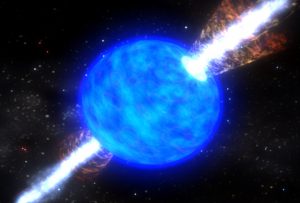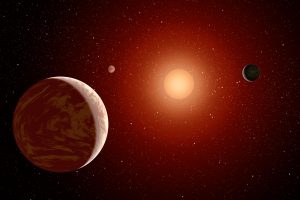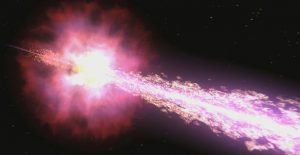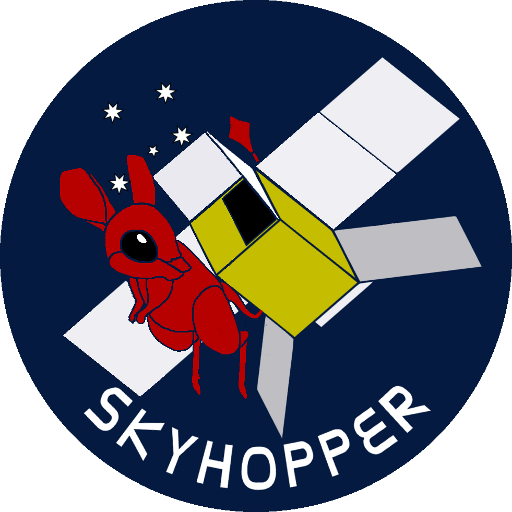For The Public
SkyHopper is an international collaboration to put a small robotic infrared telescope in space to observe some of the most distant and powerful explosions in the Universe, and to search and characterize planets orbiting other stars, alongside other exciting new science.
Bright objects in space emit light at a wide range of frequencies, but individual telescopes can each only see a small range. Infrared light, which is at longer wavelengths than visible, is ideal for observing light from some of the most distant objects in the Universe. However, infrared telescopes on Earth are hindered by the fact that the water in our atmosphere absorbs a substantial amount of the light coming through at infrared frequencies, and glows at similar frequencies, creating an elevated background. By sending our telescope to space, we can get above that atmosphere and have a much clearer view of astronomical objects. And by employing CubeSat technology, we can do it all on a relatively small budget.
SkyHopper is optimized for “transient” science — that is, it will observe sources that change with time. The three main science targets for SkyHopper are:
- Distant gamma-ray bursts – Existing space telescopes looking at high-energy gamma radiation see hundreds of bright flashes of light every year. These are due to powerful explosions of distant stars, and are visible from across the observable universe. Optical (visible-light) telescopes can follow up on these bursts and observe the explosion “afterglow”, produced by the interaction of the shock-wave with the surrounding inter-stellar gas. However, the most distant gamma-ray bursts require follow-up in the infrared because of cosmological redshift of the light. SkyHopper will be able to quickly respond to gamma-ray burst alerts and point at the sources, letting us see the early afterglows of the most distant explosions in the Universe. Since the more distant an object, the further back in time we see it, SkyHopper’s observations will contribute to our understanding of how the first generations of stars and galaxies are formed in the youth of the Universe.
- Cosmic Infrared Background. – Even the most powerful telescopes such as Hubble are not capable of detecting the faintest and smallest galaxies in the Universe, which are considered to be the most abundant type in the galaxy. These too-faint-to-be-seen galaxies could host a significant fraction of stars, and the collective unresolved light from these sources contributes to the so called Cosmic Infrared Background radiation, which can be studied to infer the galaxy’s properties across cosmic time. The study of the statistical properties of the Cosmic Infrared Background is conceptually similar to that of its more famous counterpart at longer wavelengths, the “Cosmic Microwave Background”. Both require observations of large areas of the sky, very precise characterization of the instrumental noise, and accurate subtraction of contributions from foreground sources. For this, a small aperture, large field of view space telescope like SkyHopper, which can dedicate months of observing time to this measurement, can perform even better than much more expensive counterparts such as Hubble, limited by their very small field of view.
- Exoplanets around red dwarf stars – Thanks to recent observations, we now know that the Galaxy is teeming with planets — on average, each star in the night sky has at least one planet in orbit around it. The Kepler space telescope has found thousands of planets orbiting other stars by making use of the transit technique — watching as a star gets periodically dimmer due to its planet passing in front of it in its orbit. However, despite this bounty of thousands of exoplanets, we know of very few that are within their star’s “habitable zone,” the orbital distance at which the surface temperature should allow water to pool on the surface in liquid form. Some astronomers have suggested that the best approach for finding potentially habitable planets would be to look not at Sun-like stars, but at red dwarf stars. These smaller, cooler stars are far more numerous in the Galaxy and have habitable zones much closer to them than larger stars do. This improves the chance of an alignment favourable for transit studies, and vastly increases the number of targets, but infrared observations are required. SkyHopper will help us find habitable planets by looking for transits on red dwarf stars, an important step in the search for life beyond our Solar System.
- Other transient sources – The so-called “transient sky” is still wide open for exploration. Because very few telescopes at any wavelength range are optimized to look for short time-period changes in their targets, there’s a vast frontier where new space phenomena might yet be discovered. One of the most exciting astronomical discoveries in recent years has been that of Fast Radio Bursts (FRBs): short (millisecond-timescale) flashes of radio light from unknown distant sources. SkyHopper will be capable of following up FRBs to search for infrared afterglows, potentially giving us invaluable information about their origins and nature. Because of SkyHopper’s fast response and its frequency range in the infrared, it will be exploring a part of the transient sky that might contain other new phenomena yet to be imagined. In addition to the expected targets listed above, SkyHopper will make use of its fast response and unique perspective to keep an eye out for the unexpected.




Rapid Response Telescope